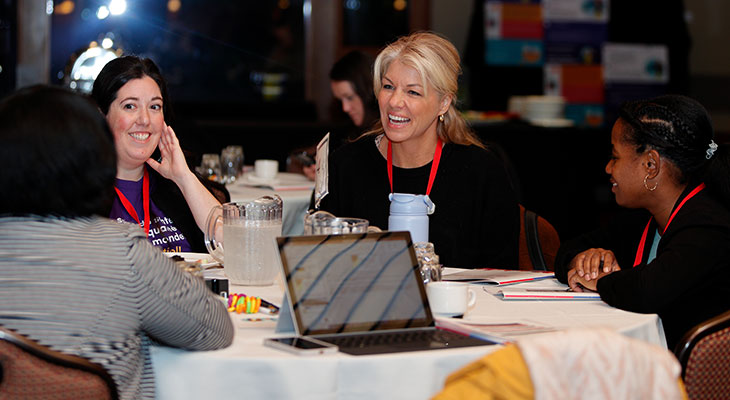Traditional palliative care models often overlook the unique needs and challenges of people experiencing homelessness or vulnerable housing, including needs like income security, food and more personalized, compassionate care. The Improving Equity in Access to Palliative Care collaborative brings communities from coast to coast to design and implement innovative models that improve access to care.
In this blog, we’ll take a closer look at some of the aspects of these models, based on insights from a recent two-day workshop hosted by Healthcare Excellence Canada and the Canadian Partnership Against Cancer. The workshop brought together care providers and organizations participating in the collaborative along with HEC coaches, advisors, and special guests to exchange learnings from their own communities and examine ways to improve access to care using a health equity approach. These participants are part of the first cohort of communities to participate in the Improving Equity in Access to Palliative Care collaborative. Here are some of the key takeaways they shared.
Use a people-centred approach
A common theme echoed throughout both days was the importance of delivering care with a people-centred approach. This includes shifting away from a biomedical model (where health focuses on physical factors like the absence of disease) to a more people-centred approach that tailors care and addresses the unique needs of individuals. It involves understanding both the structural and social determinants of health.
To effectively provide care, it’s important that care providers strive to understand the needs, wishes, hopes, dreams and ultimately, the care needs of those they serve. This requires building meaningful and trusting relationships with the person, rather than having the provider or system at the centre.
One such example of this is the Toronto-based partnership between Second Mile Club of Toronto, a division of Kensington Health, the Inner City Health Associates and The Neighbourhood Group to deliver the PEACH (Palliative Education And Care for the Homeless) Program. These organizations collaboratively provide trauma-informed medical care, psychosocial support, advocacy, health navigation and case management to individuals living with life-limiting illnesses while experiencing homelessness. With their interprofessional team, including individuals with lived and living experience, they have built trust by focusing on relationship building, meeting clients where they are at and connecting them with supports while providing equitable and accessible care.
An individualized and people-centred approach is also essential when working with First Nations, Inuit and Métis communities, as reflected on by Dr. James Makokis during his presentation on the Nehiyô beliefs on death and dying, palliative care and homelessness. Highlighting the detrimental effects of colonization on Indigenous health, he emphasized the importance of integrating Indigenous ceremonies and knowledge within western healthcare to deliver culturally sensitive care.
Work in partnership
Many healthcare services are not available to individuals without a fixed address. Communities are addressing this through partnerships and integrated care as seen with the Palliative Outreach Resource Team (PORT), a mobile palliative care program that brings care directly to people experiencing homelessness or vulnerable housing by connecting them to caregivers, palliative care and other health and social support systems. Jill Gerke, Dr. Kelli Stajduhar and the members of the PORT team – a collaboration of the University of Victoria, Island Health, and Victoria Cool Aid Society – shared the evolution of their program during their presentation and highlighted the vital role of collaborating with community partners to deliver a holistic and comprehensive palliative care program that addresses structural barriers of health.
These types of integrated care are also available in other communities such as Maison du Père. This Montreal-based organization offers housing solutions (temporary accommodations, transitional and permanent housing) alongside healthcare, social and financial support services to men experiencing homelessness or vulnerable housing. The community’s success in tailoring housing solutions and supports to individual needs is due in part to the collaborations they have with healthcare networks, municipal authorities and various community organizations and private partners.

How to define success
How do we know these new models of care are making an impact? Holly Prince, Dr. Cara Bablitz and Dr. Kelli Stajduhar explored this question by looking at evaluation methods, the challenges of creating sustainable impact and the role data and storytelling play in highlighting the impact of their efforts and advocating for systemic change.
Key takeaways for the development and evaluation of these programs include:
- Ensure programs are community-led and respond to the needs of the community.
- Recognize and adapt to the complex nature of palliative care work including the emotional considerations of end-of-life care.
- Honour and highlight people's stories as a way to demonstrate the effects of care.
- Be flexible in evaluation and integrate these measures into existing processes.
- Use evaluations as practical ways to improve care.
What’s next?
Many current models of palliative care often fail to meet the health and social care needs faced by people experiencing homelessness or vulnerable housing. Communities across the country, including those in the first cohort of the collaborative, are exploring new approaches that help improve equity and increase access to care. This underscores the need to broaden our approaches to take an equity-oriented approach to improving access, safety, experience, and quality of care, particularly for those who experience structural and systemic barriers to care.
Looking for additional resources or to get involved?
- Explore culturally safe and equitable care through HEC’s Equity, Diversity and Inclusion Virtual Learning Exchange, A Journey We Walk Together: Strengthening Indigenous Cultural Competency in Health Organizations report and the Rapid review: Delivering primary care services in non-traditional healthcare settings to people experiencing homelessness
- Learn more about the first cohort of the Improving Equity in Access to Palliative Care collaborative.
- Access resources like Beginning the journey into the spirit world: First Nations, Inuit and Métis approaches to palliative and end-of-life care in Canada, EQUIP Equity Essentials and the Where Are All my Relations? Stories of Indigenous Homelessness in B.C. video series.
